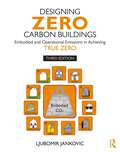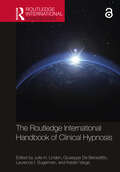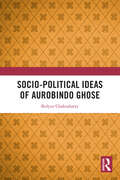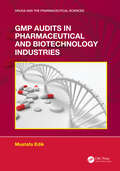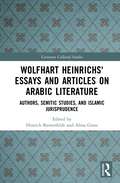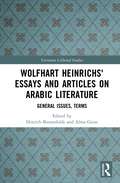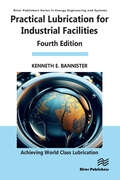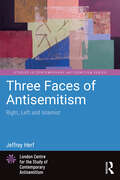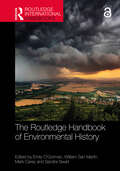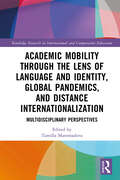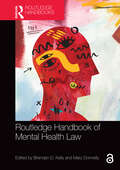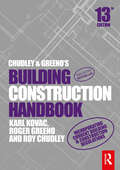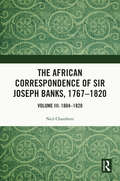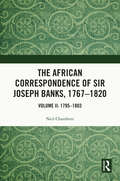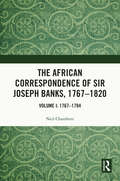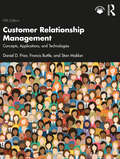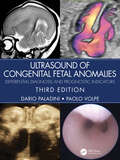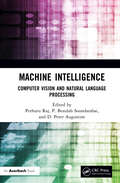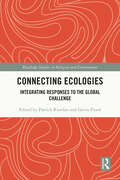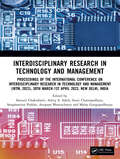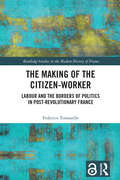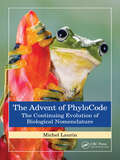- Table View
- List View
Conference Interpreting: A Student’s Practice Book
by Andrew GilliesConference Interpreting: A Student’s Practice Book brings together a comprehensive compilation of tried and tested practical exercises which hone the sub-skills that make up successful conference interpreting. Unique in its exclusively practical focus, this book serves as a reference for students and teachers seeking to solve specific interpreting-related difficulties. By breaking down the necessary skills and linking these to the most relevant and effective exercises, students can target their areas of weakness and work more efficiently towards greater interpreting competence. This second edition includes a comprehensive update of the text, with new exercises and revised example speeches throughout, as well as three entirely new chapters on Activation, Voice and Early Simultaneous Exercises.Split into four Parts, this book includes a detailed introduction offering general principles for effective practice drawn from the author’s own extensive experience as an interpreter and interpreter-trainer. The second ‘language’ section covers language enhancement at this very high level, an area that standard language courses and textbooks are unable to deal with. The last two sections cover the key sub-skills needed to effectively handle the two components of conference interpreting: simultaneous and consecutive interpreting. This book is not language-specific and, as such, is an essential resource for all interpreting students, regardless of their language combination.
Designing Zero Carbon Buildings: Embodied and Operational Emissions in Achieving True Zero
by Ljubomir JankovicIn this significantly revised third edition, Designing Zero Carbon Buildings combines embodied and operational emissions into a structured approach for achieving zero emissions by a specific year with certainty.Simulation and quantitative methods are introduced in parallel with analogue scale models to demonstrate how things work in buildings. Where equations are provided, this is also explained with common analogue objects, pictures, and narratives. A Zero Equation introduced in this book is not only explained as an equation but also as an analogy with a jam jar and spoons, making the book accessible for a range of audiences. Tasks for simple experiments, exercises, discussion questions, and summaries of design principles are provided in closing lines of chapters.This book introduces new case studies, in addition to an updated case study of the Birmingham Zero Carbon House, applying embodied and operational emissions to assess their status using the Zero Equation. The approach introduced brings about a sense of realism into what true zero emissions mean. Written for students, educators, architects, engineers, modellers, practising designers, sustainability consultants, and others, it is a major positive step towards design thinking that makes achieving zero carbon emissions a reality.
The Routledge International Handbook of Clinical Hypnosis (Routledge International Handbooks)
by Laurence I. Sugarman Julie H. Linden Giuseppe De Benedittis Katalin VargaThe Routledge International Handbook of Clinical Hypnosis explores and clarifies the challenge of defining what hypnosis is and how best to integrate it into treatment.It contains state-of-the-art neuroscience, cutting-edge practice, and future-oriented visions of clinical hypnosis integrated into all aspects of health and clinical care. Chapters gather current research, theories, and applications in order to view clinical hypnosis through the lens of neurobiological plasticity and reveal the central role of hypnosis in health care. This handbook catalogs the utility of clinical hypnosis as a biopsychosocial intervention amid a broad range of treatment modalities and contexts. It features contributions from esteemed international contributors, covering topics such as self-hypnosis, key theories of hypnosis, hypnosis and trauma, hypnosis and chronic pain management, attachment, and more.This handbook is essential for researchers, clinicians, and newcomers to clinical hypnosis, in medical schools, hospitals, and other healthcare settings.Chapters 4, 35, 62 and 63 of this book are freely available as a downloadable Open Access PDF at http://www.taylorfrancis.com under a Creative Commons Attribution-Non Commercial-No Derivatives (CC-BY-NC-ND) 4.0 license.
Socio-political Ideas of Aurobindo Ghose
by Bidyut ChakrabartyBy focusing on the socio-political ideas of the nationalist Aurobindo Ghosh (1872-1950), the book is an analytical dissection of his ideational vision which is still a relatively under-studied area of nationalist thoughts. During the perod, 1893-1910, Ghosh radically altered the texture of Indian nationalism by dwelling on how nationalism flourished in different parts of India, particularly, Japan, Italy and Ireland. conceptually different from the prevalent form of nationalist voice, it was he who clearly charted out a new course for anti-British campaign that fully unfolded with the appearance of Gandhi (1869-1948) on the Indian political scene. So, Aurobindo's politico-ideological vision ushered in a new era in the nationalist battle for India's political emancipation. Not only is the book therefore an intervention in the nationalist thought, but also devised new conceptual parameters for comprehending the radicalization of politico-ideological voices while simultaneously mobilizing those who were ready to make supreme sacrifices for the cause.
GMP Audits in Pharmaceutical and Biotechnology Industries (ISSN)
by Mustafa EdikThe fact that good manufacturing practice (GMP) audits in the pharmaceutical and biotechnology industries have to be evaluated, and with very limited resources, has created a gap in this field. The lack of trained and qualified GMP auditors is on the rise in all organizations that are required to implement FDA, EMA, MHRA, WHO, TGA, and PIC/S regulations. This volume is an essential reference source for those organizations operating in the field of health and presents the basic knowledge needed to perform audits. The author also provides useful tips and a selection of samples about GMP audits that are indispensable for professionals and health inspectors working in industry and health authorities.Features An essential reference source for those organizations operating in the field of health and presents the basic knowledge needed to perform audits Anyone working in the manufacturing sector needs to be aware of GMP, be able to identify operational flaws as well as legal violations, and have a clear understanding of how to meet GMP standards Assists readers in understanding the importance of GMP and how they can apply each aspect in their working environment Covers a global regulatory landscape Suitable for relevant degree courses including industrial pharmaceutics and pharmaceutical biotechnology
Wolfhart Heinrichsʼ Essays and Articles on Arabic Literature: Authors, Semitic Studies, and Islamic Jurisprudence (Variorum Collected Studies)
by Hinrich Biesterfeldt Alma GieseWolfhart Heinrichs’ Essays and Articles on Arabic Literature: Authors, Semitic Studies, and Islamic Jurisprudence is the second of two volumes that showcase a great number of Heinrichs’ writings on Arabic literature, Semitic Studies, and Islamic jurisprudence.Wolfhart Heinrichs (1941-2014) was James Richard Jewett Professor of Arabic at Harvard University. He is remembered as a significant adviser to Fuat Sezginʼs fundamental Geschichte des arabischen Schrifttums; as an editor of and contributor to the Encyclopaedia of Islam, Second edition; and, most importantly, as an author of many independent studies on Arabic literature, many of which were groundbreaking in the history of Arabic philology. He is also known for his studies on Semitic linguistics and Islamic jurisprudence.This volume collects relevant bibliographical data, offers an introductory essay on the author by his distinguished student Michael Cooperson (UCLA), and presents reprints of his articles and essays. These include the remainder of Heinrichsʼ contributions to Arabic literature, dealing with a number of classical Arabic authors, Semitic studies in general (among them Aramaic and Neo-Aramaic), and Rhetoric as used in Islamic jurisprudence and in the game of scholarly debate (jadal). An index of classical authors, book titles, and technical terms concludes the volume.This volume and its companion will appeal to students and researchers in the fields of Arabic literature, Semitic Studies, and Islamic jurisprudence.
Wolfhart Heinrichs´ Essays and Articles on Arabic Literature: General Issues, Terms (Variorum Collected Studies)
by Hinrich Biesterfeldt Alma GieseWolfhart Heinrichs’ Essays and Articles on Arabic Literature: General Issues, Terms is the first of two volumes that showcase a great number of Heinrichsʼ writings on his central field of research: Arabic literature. This volume specifically looks at poetry and rhetoric, and their indigenous theories and terminologies.Wolfhart Heinrichs (1941-2014) was James Richard Jewett Professor of Arabic at Harvard University. He is remembered as a significant adviser to Fuat Sezginʼs fundamental Geschichte des arabischen Schrifttums; as an editor of and contributor to the Encyclopaedia of Islam, Second edition; and, most importantly, as an author of many independent studies on Arabic literature, many which were groundbreaking in the history of Arabic philology. He is also known for his studies on Semitic linguistics and Islamic jurisprudence.This volume collects relevant bibliographical data, offers an introductory essay on the author by his distinguished student Michael Cooperson (UCLA), and provides a selection of Wolfhart Heinrichs’ essays. The articles in this volume deal with general issues in the field that are central to pre-modern Arab and Islamic culture, and their concepts and terminologies. An index of classical authors, book titles, and technical terms concludes the volume.This volume and the accompanying volume will appeal to students and researchers in the field of Arabic and Islamic Studies, and particularly to those interested in Arabic literature.
Practical Lubrication for Industrial Facilities (River Publishers Series in Energy Engineering and Systems)
by Kenneth BannisterPractical Lubrication for Industrial Facilities – Fourth Edition, is a blueprint manual for any person, department, or corporation wanting to acquire practical working knowledge in the field of industrial lubrication study and application. For this all-new fourth edition, the book has been extensively rewritten and updated for improved clarity and understanding. The addition of color tables, diagrams, and photographs serves to provide an improved text that is comprehensive, meaningful, practical, and easier to read.With the advent of the ISO 55001 asset management standard, the ICML 55® world lubrication standard, and the rapidly rising interest and professional industrial lubrication certification of engineers and maintenance/lubrication practitioners working in the field of mechanized equipment assets, this book provides a one-stop reference manual for individuals, departments and corporations who wish to study/understand practical lubrication theory and its real-world application within the industry.Furthermore, the book is designed to deliver the basic building blocks required to implement a practical and meaningful lubrication management program that meets and exceeds the requirements set out in the aforementioned ISO 55001 and ICML 55 standards, designed to truly define "World Class."
Three Faces of Antisemitism: Right, Left and Islamist (Studies in Contemporary Antisemitism)
by Jeffrey HerfThree Faces of Antisemitism examines the three primary forms of antisemitism as they emerged in modern and contemporary Germany, and then in other countries.The chapters draw on the author’s historical scholarship over the years on the form antisemitism assumed on the far right in Weimar and Nazi Germany, in the Communist regime in East Germany, and in the West German radical left, and in Islamist organizations during World War II and the Holocaust, and afterward in the Middle East. The resurgence of antisemitism since the attacks of September 11, 2001, has origins in the ideas, events, and circumstances in Europe and the Middle East in the half century from the 1920s to the 1970s. This book covers the period since 1945 when neo-Nazism was on the fringes of Western and world politics, and the persistence of antisemitism took place primarily when its leftist and Islamist forms combined antisemitism with anti-Zionism in attacks on the state of Israel. The collection includes recent essays of commentary that draw attention to the simultaneous presence of antisemitism’s three faces. While scholarship on the antisemitism of the Nazi regime and the Holocaust remains crucial, the scholarly, intellectual, and political effort to fight antisemitism in our times requires the examination of antisemitism’s leftist and Islamist forms as well.This book will be of interest to scholars researching antisemitism, racism, conspiracy theories, the far right, the far left, and Islamism.
The Routledge Handbook of Environmental History (Routledge International Handbooks)
by Mark Carey Sandra Swart Emily O’Gorman William San MartínThe Routledge Handbook of Environmental History presents a cutting-edge overview of the dynamic and ever-expanding field of environmental history. It addresses recent transformations in the field and responses to shifting scholarly, political, and environmental landscapes.The handbook fully and critically engages with recent exciting changes, contextualizes them within longer-term shifts in the field, and charts potential new directions for study. It focuses on five key areas: Theories and concepts related to changing considerations of social justice, including postcolonial, antiracist, and feminist approaches, and the field’s growing emphasis on multiple human voices and agencies. The roles of non-humans and the more-than-human in the telling of environmental histories, from animals and plants to insects as vectors of disease and the influences of water and ice, the changing theoretical approaches and the influence of concepts in related areas such as animal and discard studies. How changes in theories and concepts are shaping methods in environmental history and shifting approaches to traditional sources like archives and oral histories as well as experiments by practitioners with new methods and sources. Responses to a range of current complex problems, such as climate change, and how environmental historians can best help mitigate and resolve these problems. Diverse ways in which environmental historians disseminate their research within and beyond academia, including new modes of research dissemination, teaching, and engagements with stakeholders and the policy arena. This is an important resource for environmental historians, researchers and students in the related fields of political ecology, environmental studies, natural resources management and environmental planning.Chapters 9, 10 and 26 of this book are freely available as a downloadable Open Access PDF at http://www.taylorfrancis.com under a Creative Commons Attribution-Non Commercial-No Derivatives (CC-BY-NC-ND) 4.0 license.
Cities, Citizenship and Jews in France and the United States, 1905–2022 (Routledge Studies in Modern History)
by Josef W. KonvitzThis comparative, transatlantic two-volume work covers nearly 120 years of the history of the rights, integration, and security of the Jewish people in both the United States and France, the countries with the largest and third-largest Jewish populations.Religious freedom and secularism have evolved differently in France and the United States, reinforcing their separate national identities. Yet there are parallels to their Jewish history, and in how the security of Jews has repeatedly defined and tested the national interests of France and the United States in world affairs. Drawing on the author’s personal experience as an international civil servant, these volumes explore topics such as tensions and common interests between France and the United States, the memory of the Shoah, social mobility, the tepid commitment of the United States to the rights of French Jews during World War II, trends in antisemitism and tolerance, and global climate change as a threat to largely coastal Jewish communities. They highlight what makes insecurity different in the 21st century and why a paradigm shift in policy is needed.This title is intended both for a general audience and advanced undergraduate and graduate students interested in Jewish history, urban history and international relations.
Academic Mobility through the Lens of Language and Identity, Global Pandemics, and Distance Internationalization: Multidisciplinary Perspectives (Routledge Research in International and Comparative Education)
by Tamilla MammadovaThis book takes a critical perspective on international academic mobility and contextualizes this mobility through different key factors including global pandemics, identity construction, intercultural sensitivity, and cultural engagement.Using a multidisciplinary approach, the volume investigates the current trends of international mobility programs with consideration to the new normal through social, political, economic, and educational factors among mobility exchange actors. Contesting established approaches to international academic mobility in paradigmatic contexts, the volume investigates the effects and implications of distance internationalization as an emerging concept, juxtaposing the traditional context of academic mobility with a newly emerging virtual one as a key catalyst for change.Offering a range of authentic studies, reviews, and cases to challenge international global education, this timely book will appeal to researchers, scholars, and postgraduate students in the fields of higher education research, international and comparative education, and the sociology of education more broadly.
Routledge Handbook of Mental Health Law (Routledge Handbooks in Law)
by Brendan D. Kelly and Mary DonnellyMental health law is a rapidly evolving area of practice and research, with growing global dimensions. This work reflects the increasing importance of this field, critically discussing key issues of controversy and debate, and providing up-to-date analysis of cutting-edge developments in Africa, Asia, Europe, the Americas, and Australia.This is a timely moment for this book to appear. The United Nations’ Convention on the Rights of Persons with Disabilities (2006) sought to transform the landscape in which mental health law is developed and implemented. This Convention, along with other developments, has, to varying degrees, informed sweeping legislative reforms in many countries around the world. These and other developments are discussed here. Contributors come from a wide range of countries and a variety of academic backgrounds including ethics, law, philosophy, psychiatry, and psychology. Some contributions are also informed by lived experience, whether in person or as family members. The result is a rich, polyphonic, and sometimes discordant account of what mental health law is and what it might be.The Handbook is aimed at mental health scholars and practitioners as well as students of law, human rights, disability studies, and psychiatry, and campaigners and law- and policy-makers.
Chudley and Greeno's Building Construction Handbook
by Roy Chudley Roger Greeno Karl KovacThe 13th edition of Chudley and Greeno’s Building Construction Handbook remains THE authoritative reference for all construction students and professionals. The principles and processes of construction are explained with the concepts of design included where appropriate. Extensive coverage of building construction practice, techniques and regulations representing both traditional procedures and modern developments are included to provide the most comprehensive and easy-to-understand guide to building construction.This new edition has been updated to reflect recent changes to the Building Regulations, as well as including new material on modern methods of construction, greater emphasis on sustainability, health and safety, and coverage of heat pumps, photovoltaics, underfloor heating and rainwater harvesting.Chudley and Greeno’s Building Construction Handbook is the essential, easy-to-use resource for undergraduate and vocational students on a wide range of courses including NVQ and BTEC National, through to Higher National Certificate and Diploma, to Foundation and three-year degree level. It is also a useful practical reference for building designers, contractors and others engaged in the construction industry.
The African Correspondence of Sir Joseph Banks, 1767–1820: Volume III 1804–1820
by Neil ChambersThis edition brings together in three fully edited volumes the correspondence and associated papers of Sir Joseph Banks regarding European and especially British exploration of Africa from 1767–1820, for the first time publishing this globally scattered material in one place, thereby revolutionizing its availability and understanding of the activities of a key figure who helped organize and publish a series of missions to penetrate the African interior, mainly from West Africa and by crossing the Sahara from Cairo and Tripoli. Banks was a founder in 1788 of the African Association, which mounted many of these missions, including those of Mungo Park to explore the River Niger, and J.L. Burkhardt exploring Syria, Arabia and Egypt. At the time, little was known about the African interior, its peoples, kingdoms and resources, and the aim of the African Association under Banks was to discover what lay there, to make contact with and study its societies, to map them and their lands and help establish trading links. Banks also maintained a lively correspondence with British diplomatic representatives in North Africa, such as James Mario Matra at Tangier and Henry Salt in Cairo, who were a rich source of news. Moreover, as unofficial director of the royal gardens at Kew he sent pioneering plant collectors to gather plants in South Africa, vastly boosting knowledge of this region’s important flora. At home, he corresponded with politicians, government officials, entrepreneurs, navigators, naturalists and campaigners like William Wilberforce about a great range of issues surrounding Africa. This work is multi-disciplinary and will stand alongside existing series of Banks’s correspondence published by Neil Chambers (Scientific Correspondence, 2007; Indian and Pacific Correspondence, 2007–14). It will appeal to scholars of African history in the Early Modern Period, to those studying exploration and collecting as well as those interested in natural history, the history of science, geography, cartography and the Enlightenment. An Introduction, detailed Calendar of Correspondents, Timelines for each volume and a comprehensive Index supplement the footnotes to nearly 800 documents included in this fascinating and comprehensive new series.
The African Correspondence of Sir Joseph Banks, 1767–1820: Volume II: 1795–1803
by Neil ChambersThis edition brings together in three fully edited volumes the correspondence and associated papers of Sir Joseph Banks regarding European and especially British exploration of Africa from 1767–1820, for the first time publishing this globally scattered material in one place, thereby revolutionizing its availability and understanding of the activities of a key figure who helped organize and publish a series of missions to penetrate the African interior, mainly from West Africa and by crossing the Sahara from Cairo and Tripoli. Banks was a founder in 1788 of the African Association, which mounted many of these missions, including those of Mungo Park to explore the River Niger, and J.L. Burkhardt exploring Syria, Arabia and Egypt. At the time, little was known about the African interior, its peoples, kingdoms and resources, and the aim of the African Association under Banks was to discover what lay there, to make contact with and study its societies, to map them and their lands and help establish trading links. Banks also maintained a lively correspondence with British diplomatic representatives in North Africa, such as James Mario Matra at Tangier and Henry Salt in Cairo, who were a rich source of news. Moreover, as unofficial director of the royal gardens at Kew he sent pioneering plant collectors to gather plants in South Africa, vastly boosting knowledge of this region’s important flora. At home, he corresponded with politicians, government officials, entrepreneurs, navigators, naturalists and campaigners like William Wilberforce about a great range of issues surrounding Africa. This work is multi-disciplinary and will stand alongside existing series of Banks’s correspondence published by Neil Chambers (Scientific Correspondence, 2007; Indian and Pacific Correspondence, 2007–14). It will appeal to scholars of African history in the Early Modern Period, to those studying exploration and collecting as well as those interested in natural history, the history of science, geography, cartography and the Enlightenment. An Introduction, detailed Calendar of Correspondents, Timelines for each volume and a comprehensive Index supplement the footnotes to nearly 800 documents included in this fascinating and comprehensive new series.
The African Correspondence of Sir Joseph Banks, 1767–1820: Volume I: 1767–1794
by Neil ChambersThis edition brings together in three fully edited volumes the correspondence and associated papers of Sir Joseph Banks regarding European and especially British exploration of Africa from 1767–1820, for the first time publishing this globally scattered material in one place, thereby revolutionizing its availability and understanding of the activities of a key figure who helped organize and publish a series of missions to penetrate the African interior, mainly from West Africa and by crossing the Sahara from Cairo and Tripoli. Banks was a founder in 1788 of the African Association, which mounted many of these missions, including those of Mungo Park to explore the River Niger, and J.L. Burkhardt exploring Syria, Arabia and Egypt. At the time, little was known about the African interior, its peoples, kingdoms and resources, and the aim of the African Association under Banks was to discover what lay there, to make contact with and study its societies, to map them and their lands and help establish trading links. Banks also maintained a lively correspondence with British diplomatic representatives in North Africa, such as James Mario Matra at Tangier and Henry Salt in Cairo, who were a rich source of news. Moreover, as unofficial director of the royal gardens at Kew he sent pioneering plant collectors to gather plants in South Africa, vastly boosting knowledge of this region’s important flora. At home, he corresponded with politicians, government officials, entrepreneurs, navigators, naturalists and campaigners like William Wilberforce about a great range of issues surrounding Africa. This work is multi-disciplinary and will stand alongside existing series of Banks’s correspondence published by Neil Chambers (Scientific Correspondence, 2007; Indian and Pacific Correspondence, 2007–14). It will appeal to scholars of African history in the Early Modern Period, to those studying exploration and collecting as well as those interested in natural history, the history of science, geography, cartography and the Enlightenment. An Introduction, detailed Calendar of Correspondents, Timelines for each volume and a comprehensive Index supplement the footnotes to nearly 800 documents included in this fascinating and comprehensive new series.
Customer Relationship Management: Concepts, Applications and Technologies
by Stan Maklan Francis Buttle Daniel D. PriorThis highly regarded textbook provides the definitive account of Customer Relationship Management (CRM) concepts, applications, and technologies, focusing on how companies can create and maintain mutually beneficial relationships with customers.Readers will gain a thorough understanding of the conceptual foundations of CRM, see CRM in practice through illustrative case examples and exercises, and understand how to organise customer data gathering, analysis, and presentation for decision making. The book achieves these outcomes by first considering strategic CRM before moving into operational CRM and, finally, onto analytical aspects of CRM. The fifth edition has been fully updated to include: A series of new case examples to illustrate CRM within various regional and industrial contexts, including those relevant to large, medium, and small enterprises A series of new exercises and discussion questions to help readers understand CRM concepts and to support pedagogical processes, particularly in higher education environments A greater emphasis on managerial applications of CRM through new content to help guide managers An updated account of new and emerging technologies relevant to CRM Expanded coverage of customer experience (CX), customer engagement (CE), and customer journey management (CJM) Customer Relationship Management is essential reading for advanced undergraduate and postgraduate students studying CRM, Sales Management, Customer Experience Management, and Relationship Marketing, as well as executives who oversee CRM functions. Online resources include an Instructor’s Manual, chapter-by-chapter PowerPoint slides, and a bank of exam questions.
Ultrasound of Congenital Fetal Anomalies: Differential Diagnosis and Prognostic Indicators
by Dario Paladini Paolo VolpeAn acclaimed overview of ultrasound for the prenatal diagnosis of congenital anomalies returns in a new enlarged edition. In particular, the coverage of both Central Nervous System congenital and acquired anomalies as well as Congenital Heart Disease has been expanded enormously, to make this an impressive comprehensive resource for Fetal Neurology and Fetal Cardiology. Together with additional new chapters on guidelines and protocols, equipment, and disorders of sexual differentiation, and new insight into fetal surgery procedures, this third edition almost becomes three books in one.
Machine Intelligence: Computer Vision and Natural Language Processing
by Pethuru Raj P. Beaulah Soundarabai D. Peter AugustineMachines are being systematically empowered to be interactive and intelligent in their operations, offerings. and outputs. There are pioneering Artificial Intelligence (AI) technologies and tools. Machine and Deep Learning (ML/DL) algorithms, along with their enabling frameworks, libraries, and specialized accelerators, find particularly useful applications in computer and machine vision, human machine interfaces (HMIs), and intelligent machines. Machines that can see and perceive can bring forth deeper and decisive acceleration, automation, and augmentation capabilities to businesses as well as people in their everyday assignments. Machine vision is becoming a reality because of advancements in the computer vision and device instrumentation spaces. Machines are increasingly software-defined. That is, vision-enabling software and hardware modules are being embedded in new-generation machines to be self-, surroundings, and situation-aware.Machine Intelligence: Computer Vision and Natural Language Processing emphasizes computer vision and natural language processing as drivers of advances in machine intelligence. The book examines these technologies from the algorithmic level to the applications level. It also examines the integrative technologies enabling intelligent applications in business and industry.Features: Motion images object detection over voice using deep learning algorithms Ubiquitous computing and augmented reality in HCI Learning and reasoning in Artificial Intelligence Economic sustainability, mindfulness, and diversity in the age of artificial intelligence and machine learning Streaming analytics for healthcare and retail domains Covering established and emerging technologies in machine vision, the book focuses on recent and novel applications and discusses state-of-the-art technologies and tools.
Connecting Ecologies: Integrating Responses to the Global Challenge (Routledge Studies in Religion and Environment)
by Gavin Flood Patrick RiordanConnecting Ecologies focuses on the environmental aspects of Pope Francis’ encyclical Laudato Si’ and the challenge to care for our common home. It considers how best to devise and implement the new societal models needed to tackle the ecological problems facing the world today. The book addresses the need for and complexity of an integral ecology, one that looks not only at physical and biological processes but also allows for the contributions of theology, philosophy, spirituality, and psychology, including the implications for the human and social sciences. The contributions document four categories of resonances, resources, requirements, and responses evoked by a reading of Laudato Si’ and include consideration of other faith traditions. They reflect on how care for our common home motivates people in different places, cultures, and professions to cooperate for myriad goods in common. The volume is particularly relevant for scholars working in religious studies and theology with an interest in ecology, the environment, and the Anthropocene.
Interdisciplinary Research in Technology and Management: Proceedings of the International Conference on Interdisciplinary Research in Technology and Management (IRTM, 2023), 30th March-1st April 2023, New Delhi, India
by Satyajit Chakrabarti Sanghamitra Poddar Malay Gangopadhyaya Ashiq A. Sakib Anupam Bhattacharya Souti ChattopadhyayIRTM 2023We live in an inter-connected world. In the era of Industry 5.0, technology is getting embedded more and more in the way ‘we learn, live, work and play’.This progression is accelerating at a pace never seen before. Inter disciplinary and collaborative research across disciplines within the Technology domain and Management domain, and across the Technology — Management interface is opening up exciting new possibilities for solving problems whose solutions are beyond the scope of a single discipline, domain or practice, and helping to create a brave, new world. We are living in an incredible time of change.Our effort to hold such an interdisciplinary conference, in the virtual mode, apparently resonated across the academic community, as was evident from the huge response that the first ever conference on “Interdisciplinary Research in Technology and Management”, (IRTM) held in February 2021 had received from participants across many countries. This has encouraged the organizers to hold the next edition of the conference physically in Kolkata on a larger scale in the online mode.The pandemic unleashed by Covid 19 in the last two years has shaken the socio-economic foundations of countries and societies to a point where the world cannot be the same as before the pandemic. It has re-focused the world’s attention on the priority of healthcare, and healthcare infrastructure and its innovative management.Inevitably, questions have again been raised more vehemently on what kind of a world we want to live in. Environmental concerns are being pursued with renewed vigour, The urgency of developing new, robust infrastructure relevant for the new world is gaining wider consensus.By 2030, as reports suggest, cyber – physical systems, internet of things and wearable technology will be everywhere and in everything, renewable energy will power the world, and digital entertainment will take centre stage among other developments.The third edition of the conference on “Interdisciplinary Research in Technology and Management” attempts to spotlight the above concerns. The number of tracks on which papers are invited from scholars, researchers, consultants and practitioners to share their interdisciplinary research and consultative work has been enlarged. As before, the papers will be peer reviewed and authors of the selected papers will be invited to present their papers in the IRTM conference.The presentation of papers will be interspersed with Keynote Talks by eminent experts on the theme of the conference or individual domains.
The United Nations, Indo-Pacific and Korean Peninsula: An Emerging Security Architecture (Routledge Studies on Think Asia)
by Shin-Wha Lee, Jagannath PandaThe United Nations, Indo-Pacific and Korean Peninsula focuses on the United Nations (UN) and its frameworks to examine the power politics on the two of the world’s more politically sensitive and geo-strategically crucial regions of the Korean Peninsula and the Indo-Pacific. This book provides answers to broader questions that are relevant to the global emerging peace architecture. The book is divided into three parts: global, Indo-Pacific and the Korean Peninsula. The first part analyses the competing world views of the U.S, China, Japan, and Korea and the evolvement of UN debates on global and regional security, with special emphasis on the Indo-Pacific and the Korean Peninsula. The second part concerns major bilateral or multilateral security issues facing Indo-Pacific countries and their UN debates in this regard. In particular, with new developments in the Indo-Pacific, such as the Quad process involving the Australia-India-Japan-United States and an anticipation expansion of the Group of Seven (G-7), chapters analyse how these mechanisms expand their focus within the scope of Indo-Pacific power politics. Part three focuses on the UN centered debates on two Koreas and their strategic fallouts at regional and global levels. Examining the security order evolving around the politics of the Indo-Pacific regions and Korean Peninsula and analysing the relevance of the UN and its mechanisms, this book will be of interest to researchers studying International Relations, Security Studies, Asian Studies, in particular Korean Studies and the Indo-Pacific.
The Making of the Citizen-Worker: Labour and the Borders of Politics in Post-revolutionary France (Routledge Studies in the Modern History of France)
by Federico TomaselloOver the course of the 19th century, European societies started thinking of themselves as “civilisations of work.” In the wake of the political and industrial revolutions, labour as a human activity and condition gradually came to embody a general principle of order, progress, and governance. How did work become so central to our systems of citizenship and social recognition?The book addresses this question by considering the French context in the long transition between the 1789 and 1848 revolutions and focusing on a specific “fragment” of history in the early 1830s marked by a pandemic crisis and the first consequences of industrialisation. It combines the analysis of both political institutions and social movements to retrace the rise of a labour-based social contract revolving around the “citizen-worker” as the quintessential subject of rights.The first part of the book highlights the role played by the genesis of the modern social sciences and analyses it as a political process that established work as an “object” of governance and scientific investigation, thus fostering pioneering measures of welfare centred on work conditions. The second part focuses on the emergence of the concept of “working class” and the modern labour movement, which structured the world of work as a collective political “subject.”Chapter 2 of this book is freely available as a downloadable Open Access PDF at http://www.taylorfrancis.com under a Creative Commons Attribution-Non Commercial-No Derivatives (CC-BY-NC-ND) 4.0 license.
The Advent of PhyloCode: The Continuing Evolution of Biological Nomenclature
by Michel LaurinBiological nomenclature is an essential tool for storing and retrieving biological information. Yet traditional nomenclature poorly reflects evolutionary theory. Current biological nomenclature is one of the few fields promoting deliberately vague usage of technical terms. A new code based on evolutionary studies and phylogenetic results (the PhyloCode) will be a major milestone in biological nomenclature. Unfortunately, The PhyloCode and the companion volume are highly technical publications intended for practicing systematists. This book will reach a broader readership of those using nomenclature but who remain unaware of its theoretical foundations.Key Features Responds to the biodiversity crisis and the recent implementation of the PhyloCode Summarizes the spectacular progress of phylogenetics which makes it both increasingly easy and crucially important to define precisely taxon names Provides a 300-year historical perspective featuring high-profile characters, such as Linnaeus and Darwin Summarizes for a broad readership a widely scattered, highly technical and underappreciated scientific literature Documents the activities of the International Society for Phylogenetic Nomenclature, a scholarly society in which the author has played a prominent role

